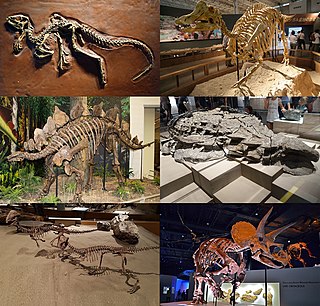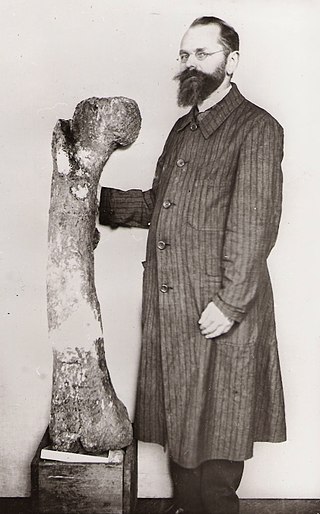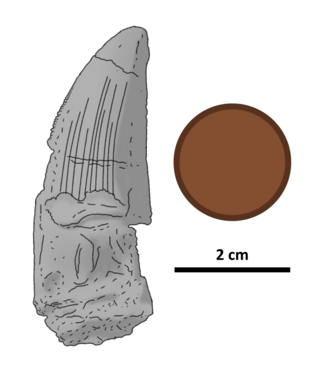| Name | Year | Formation | Location | Notes | Images |
|---|
| Aardonyx | 2010 | Elliot Formation (Early Jurassic, Sinemurian) |  South Africa South Africa | Primarily bipedal but also capable of quadrupedal locomotion |  |
| Abrictosaurus | 1975 | Elliot Formation (Early Jurassic, Hettangian to Sinemurian) |  Lesotho Lesotho
 South Africa South Africa | Known from two skulls, one of which possesses tusks, which may be an indication of sexual dimorphism [1] |  |
| Adratiklit | 2019 | El Mers Group (Middle Jurassic, Bathonian) |  Morocco Morocco | The oldest known stegosaur; related to Late Jurassic European forms despite its early age [2] |  |
| Aegyptosaurus | 1932 | Bahariya Formation, Continental intercalaire?, Farak Formation? (Late Cretaceous, Cenomanian) |  Egypt Egypt
 Niger? Niger? | Its holotype specimen was destroyed in World War II |  |
| Afromimus | 2017 | Elrhaz Formation (Early Cretaceous, Aptian to Albian) |  Niger Niger | Originally described as an African ornithomimosaur, [3] but later redescribed as a possible noasaurid [4] |  |
| Afrovenator | 1994 | Tiourarén Formation (Middle Jurassic to Late Jurassic, Bathonian to Oxfordian) |  Niger Niger | Originally thought to hail from the Early Cretaceous |  |
| Ajnabia | 2020 | Ouled Abdoun Basin (Late Cretaceous, Maastrichtian) |  Morocco Morocco | The first hadrosaur known from Africa; closely related to European lambeosaurines [5] |  |
| Algoasaurus | 1904 | Kirkwood Formation (Early Cretaceous, Berriasian to Valanginian) |  South Africa South Africa | Today known from only a few bones; several more may have been made into bricks before they could be studied [6] |  |
| Angolatitan | 2011 | Itombe Formation (Late Cretaceous, Coniacian) |  Angola Angola | The first non-avian dinosaur described from Angola |  |
| Antetonitrus | 2003 | Elliot Formation (Early Jurassic, Hettangian) |  South Africa South Africa | Had weight-bearing adaptations in all its limbs, although its forelimbs retain adaptations for grasping | 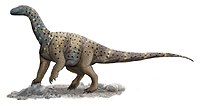 |
| Arcusaurus | 2011 | Elliot Formation (Early Jurassic, Hettangian to Pliensbachian) |  South Africa South Africa | Combines traits of basal and advanced sauropodomorphs |  |
| Atlasaurus | 1999 | Guettioua Formation (Middle Jurassic, Bathonian to Callovian) |  Morocco Morocco | Possessed relatively elongated legs for a sauropod |  |
| Australodocus | 2007 | Tendaguru Formation (Late Jurassic, Kimmeridgian to Tithonian) |  Tanzania Tanzania | Potentially an early euhelopodid [7] |  |
| Bahariasaurus | 1934 | Bahariya Formation, Farak Formation? (Late Cretaceous, Cenomanian to Turonian) |  Egypt Egypt
 Niger? Niger? | Large but known from very few remains | |
| Berberosaurus | 2007 | Azilal Formation (Early Jurassic, Toarcian) |  Morocco Morocco | One of the oldest known ceratosaurs |  |
| Blikanasaurus | 1985 | Elliot Formation (Late Triassic, Norian) |  South Africa South Africa | A "hyper-robust" form that niche partitioned with other Late Triassic Elliot sauropodomorphs [8] |  |
| Carcharodontosaurus | 1931 | Bahariya Formation, Chenini Formation?, Continental intercalaire, Echkar Formation, Elrhaz Formation?, Kem Kem Group, Wadi Milk Formation? (Late Cretaceous, Cenomanian) |  Algeria Algeria
 Egypt Egypt
 Morocco Morocco
 Niger Niger
 Sudan? Sudan?
 Tunisia Tunisia | One of the longest carnivorous dinosaurs. Two species are known |  |
| Chebsaurus | 2005 | Aïssa Formation (Middle Jurassic, Callovian) |  Algeria Algeria | Known from two juvenile specimens |  |
| Chenanisaurus | 2017 | Ouled Abdoun Basin (Late Cretaceous, Maastrichtian) |  Morocco Morocco | Potentially represents a lineage of abelisaurids endemic to Africa |  |
| Cristatusaurus | 1998 | Elrhaz Formation (Early Cretaceous, Aptian to Albian) |  Niger Niger | Usually seen as a synonym of Suchomimus , although some studies consider it to be a valid genus [9] |  |
| Deltadromeus | 1996 | Kem Kem Group (Late Cretaceous, Cenomanian) |  Morocco Morocco | Its precise phylogenetic position has been historically unstable, with multiple interpretations being suggested in the scientific literature [10] [11] [12] [13] |  |
| Dicraeosaurus | 1914 | Tendaguru Formation (Late Jurassic, Kimmeridgian to Tithonian) |  Tanzania Tanzania | A short-necked, low-browsing sauropod. Two species are known |  |
| Dracovenator | 2005 | Elliot Formation (Early Jurassic, Hettangian) |  South Africa South Africa | Only known from fragments of a skull, but those are enough to tell that it was related to Dilophosaurus |  |
| Dysalotosaurus | 1919 | Tendaguru Formation (Late Jurassic, Kimmeridgian) |  Tanzania Tanzania | Known from multiple remains that revealed much about its life history, [14] diet, [15] and even disease [16] |  |
| Elaphrosaurus | 1920 | Tendaguru Formation (Late Jurassic, Kimmeridgian) |  Tanzania Tanzania | Possessed a relatively shallow chest for a theropod its size |  |
| Elrhazosaurus | 2009 | Elrhaz Formation (Early Cretaceous, Aptian) |  Niger Niger | Closely related to Valdosaurus |  |
| Eocarcharia | 2008 | Elrhaz Formation (Early Cretaceous, Albian) |  Niger Niger | Its frontal bone was swollen into a thick band, which gave it a menacing glare |  |
| Eocursor | 2007 | Elliot Formation (Early Jurassic, Hettangian to Pliensbachian) |  South Africa South Africa | One of the most completely-known early ornithischians |  |
| Eucnemesaurus | 1920 | Elliot Formation (Late Triassic, Carnian to Norian) |  South Africa South Africa | Some fossils assigned to this genus were originally interpreted as those of a giant herrerasaurid |  |
| Euskelosaurus | 1866 | Elliot Formation (Late Triassic, Norian to Rhaetian) |  Lesotho Lesotho
 South Africa South Africa
 Zimbabwe Zimbabwe | Originally thought to have been bow-legged |  |
| Geranosaurus | 1911 | Clarens Formation (Early Jurassic, Pliensbachian to Toarcian) |  South Africa South Africa | Poorly known but potentially a heterodontosaurid |  |
| Giraffatitan | 1988 | Tendaguru Formation (Late Jurassic, Kimmeridgian to Tithonian) |  Tanzania Tanzania | Popularly associated with Brachiosaurus but several differences between the two have been noted [17] |  |
| Gryponyx | 1911 | Elliot Formation (Early Jurassic, Hettangian to Sinemurian) |  South Africa South Africa | Although usually seen as a synonym of Massospondylus , at least one study has found it to be distantly related [18] |  |
| Heterodontosaurus | 1962 | Clarens Formation, Elliot Formation (Early Jurassic, Hettangian to Pliensbachian) |  South Africa South Africa | Possessed three types of teeth, including analogues of incisors and tusks, as well as a keratinous beak |  |
| Igai | 2023 | Quseir Formation (Late Cretaceous, Campanian to Maastrichtian) |  Egypt Egypt | More closely related to European titanosaurs than to southern African ones |  |
| Ignavusaurus | 2010 | Elliot Formation (Early Jurassic, Hettangian) |  Lesotho Lesotho | Only known from a single, mostly articulated juvenile skeleton with a badly crushed skull |  |
| Inosaurus | 1960 | Bahariya Formation?, Eckhar Formation?, Tegama Group? (Early Cretaceous, Albian)? |  Niger Niger | Very poorly known | |
| Iyuku | 2022 | Kirkwood Formation (Early Cretaceous, Valanginian) |  South Africa South Africa | Uniquely known from an assemblage of mostly hatchling and juvenile fossils | |
| Janenschia | 1991 | Tendaguru Formation (Late Jurassic, Oxfordian to Tithonian) |  Tanzania Tanzania | Potentially a close relative of Bellusaurus , Haestasaurus , and Tehuelchesaurus , all of which may form a unique clade of eusauropods with possible turiasaur affinities [7] [19] [20] |  |
| Jobaria | 1999 | Tiourarén Formation (Middle Jurassic to Late Jurassic, Bathonian to Oxfordian) |  Niger Niger | Known from an almost complete skeleton |  |
| Kangnasaurus | 1915 | Kalahari Deposits Formation (Early Cretaceous, Aptian) |  South Africa South Africa | Comparisons have been made with dryosaurids [21] but at least two studies suggest a position within Elasmaria [22] [23] |  |
| Karongasaurus | 2005 | Dinosaur Beds (Early Cretaceous, Aptian) |  Malawi Malawi | Described from only a mandible and isolated teeth |  |
| Kentrosaurus | 1915 | Tendaguru Formation (Late Jurassic, Kimmeridgian to Tithonian) |  Tanzania Tanzania | Possessed two rows of plates that gradually transitioned into spikes towards the tail, as well as a long spike on each shoulder |  |
| Kholumolumo | 2020 | Elliot Formation (Late Triassic, Norian) |  Lesotho Lesotho | Before its formal description, it had been informally referred to as "Kholumolumosaurus" and "Thotobolosaurus"; the latter name means "trash heap lizard" in Sesotho, referring to how the holotype was originally found close to a trash heap |  |
| Kryptops | 2008 | Elrhaz Formation (Early Cretaceous, Aptian to Albian) |  Niger Niger | Postcranial remains referred to this abelisaurid may have instead come from a carcharodontosaurid [24] |  |
| Ledumahadi | 2018 | Elliot Formation (Early Jurassic, Hettangian to Sinemurian) |  South Africa South Africa | One of the largest Triassic dinosaurs, estimated as weighing 12 tonnes (26,000 lb) despite lacking columnar limbs like later sauropods [25] |  |
| Lesothosaurus | 1978 | Clarens Formation, Elliot Formation (Early Jurassic, Hettangian to Pliensbachian) |  Lesotho Lesotho
 South Africa South Africa | Possibly an opportunist omnivore, feeding on meat during seasons when plants are not available [26] |  |
| Lurdusaurus | 1999 | Elrhaz Formation (Early Cretaceous, Aptian to Albian) |  Niger Niger | The proportions of its body and limbs suggest it may have been a semiaquatic herbivore similar to a hippopotamus [27] |  |
| Lycorhinus | 1924 | Elliot Formation (Early Jurassic, Hettangian to Sinemurian) |  South Africa South Africa | Originally misidentified as a cynodont |  |
| Malawisaurus | 1993 | Dinosaur Beds (Early Cretaceous, Barremian to Aptian) |  Malawi Malawi | Known from abundant material, including from the skull and osteoderms, but they may not represent a single taxon [28] |  |
| Mansourasaurus | 2018 | Quseir Formation (Late Cretaceous, Campanian) |  Egypt Egypt | One of the few terrestrial vertebrates known from the Late Cretaceous of northern Africa [29] |  |
| Massospondylus | 1854 | Bushveld Sandstone, Clarens Formation, Elliot Formation, Forest Sandstone (Early Jurassic, Hettangian to Pliensbachian) |  Lesotho Lesotho
 South Africa South Africa
 Zimbabwe Zimbabwe | Abundant remains have been discovered. Several specimens were once assigned to their own genera and species |  |
| Mbiresaurus | 2022 | Pebbly Arkose Formation (Late Triassic, Carnian) |  Zimbabwe Zimbabwe | One of the oldest dinosaurs known from Africa; its discovery proves that the earliest dinosaurs were restricted to high latitudes [30] | |
| Melanorosaurus | 1924 | Elliot Formation (Late Triassic, Norian) |  South Africa South Africa | A robust, quadrupedal herbivore. Some specimens assigned to this genus may not represent the same taxon [8] |  |
| Meroktenos | 2016 | Elliot Formation (Late Triassic, Norian to Rhaetian) |  Lesotho Lesotho | Its femur was unusually robust for an animal of its size | 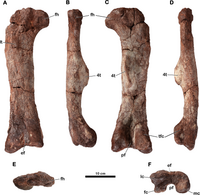 |
| Mnyamawamtuka | 2019 | Galula Formation (Late Cretaceous, Campanian to Maastrichtian) |  Tanzania Tanzania | Its specific name moyowamkia is Kiswahili for "heart tail", which references the heart-shaped cross-section of its caudal vertebrae |  |
| Ngwevu | 2019 | Clarens Formation (Early Jurassic, Pliensbachian to Toarcian) |  South Africa South Africa | Known from a skull originally assigned to Massospondylus ; it was assigned to its own genus based on its unique proportions |  |
| Nigersaurus | 1999 | Elrhaz Formation (Early Cretaceous, Aptian to Albian) |  Niger Niger | All of its teeth were at the front of its jaws, which were wider than the rest of its skull, an adaptation to low browsing |  |
| Nqwebasaurus | 2000 | Kirkwood Formation (Early Cretaceous, Berriasian) |  South Africa South Africa | The first non-avian coelurosaur named from mainland Africa |  |
| Orosaurus | 1867 | Elliot Formation? (Late Triassic to Early Jurassic, Norian to Hettangian) |  South Africa South Africa | Probably a synonym of Euskelosaurus | |
| Ostafrikasaurus | 2012 | Tendaguru Formation (Late Jurassic, Tithonian) |  Tanzania Tanzania | Described from a single tooth as an early spinosaurid [31] but ceratosaurid affinities have also been proposed [32] |  |
| Ouranosaurus | 1976 | Elrhaz Formation (Early Cretaceous, Aptian to Albian) |  Niger Niger | Had long neural spines that projected from its vertebrae, which may have supported a sail or hump in life |  |
| Paralititan | 2001 | Bahariya Formation (Late Cretaceous, Cenomanian to Turonian) |  Egypt Egypt | Would have lived in a tidal flat environment dominated by mangroves |  |
| Paranthodon | 1929 | Kirkwood Formation (Early Cretaceous, Berriasian to Valanginian) |  South Africa South Africa | Though only known from fragmentary specimens, they are enough to tell that it was a stegosaur |  |
| Pegomastax | 2012 | Elliot Formation (Early Jurassic, Sinemurian) |  South Africa South Africa | The morphology of its jaws and beak suggests a diet of tough plants |  |
| Plateosauravus | 1932 | Elliot Formation (Late Triassic, Norian) |  South Africa South Africa | Known from multiple specimens, including those of juveniles |  |
| Pulanesaura | 2015 | Elliot Formation (Early Jurassic, Hettangian to Sinemurian) |  South Africa South Africa | A low browser that lacked the extremely long neck of later sauropods | 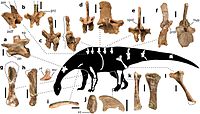 |
| Rebbachisaurus | 1954 | Kem Kem Group (Late Cretaceous, Cenomanian) |  Morocco Morocco | Carried a row of elongated neural spines, which would have supported a ridge or low sail on its back |  |
| Rugops | 2004 | Echkar Formation (Late Cretaceous, Cenomanian) |  Niger Niger | Preserves two rows of holes on the top of its skull, which may have anchored a display structure [33] or an armor-like dermis [34] |  |
| Rukwatitan | 2014 | Galula Formation (Late Cretaceous, Campanian to Maastrichtian) |  Tanzania Tanzania | One of the few titanosaurs known from central Africa, filling in a gap in their evolutionary history |  |
| Sauroniops | 2012 | Kem Kem Group (Late Cretaceous, Cenomanian) |  Morocco Morocco | Only known from a single, thickened frontal. Suggested to be a synonym of Carcharodontosaurus [13] but this has been refuted [35] |  |
| Sefapanosaurus | 2015 | Elliot Formation (Early Jurassic, Hettangian) |  South Africa South Africa | Had a distinctive cross-shaped astragalus | |
| Shingopana | 2017 | Galula Formation (Late Cretaceous, Campanian to Maastrichtian) |  Tanzania Tanzania | Most closely related to South American titanosaurs | |
| Spicomellus | 2021 | El Mers Group (Middle Jurassic, Bathonian to Callovian) |  Morocco Morocco | The oldest ankylosaur known and the first one from Africa. Uniquely, its osteoderms were fused directly to its ribs |  |
| Spinophorosaurus | 2009 | Irhazer Shale (Middle Jurassic, Bathonian) |  Niger Niger | Originally described as possessing a "thagomizer" similar to those of stegosaurs; [36] these turned out to be misidentified clavicles. [37] A high browser with tall shoulders and an elevated neck [38] |  |
| Spinosaurus | 1915 | Bahariya Formation, Chenini Formation, Kem Kem Group (Late Cretaceous, Cenomanian to Turonian) |  Algeria Algeria
 Egypt Egypt
 Morocco Morocco
 Tunisia Tunisia | Possess a myriad of features that have been suggested to be evidence of a semiaquatic lifestyle, including webbed feet [39] and a paddle-like tail; [40] it is however debated if it was a marine piscivore [41] or a shoreline generalist [42] |  |
| Spinostropheus | 2004 | Tiourarén Formation (Middle Jurassic to Late Jurassic, Bathonian to Oxfordian) |  Niger Niger | Although often considered a close relative of Elaphrosaurus , these inferences are based on a specimen that cannot actually be referred to this genus [43] |  |
| Suchomimus | 1998 | Elrhaz Formation (Early Cretaceous, Barremian to Albian) |  Niger Niger | Similar to Baryonyx but with a low sail on its back |  |
| Tataouinea | 2013 | Aïn el Guettar Formation (Early Cretaceous, Albian) |  Tunisia Tunisia | Its bones were extensively pneumatized, supporting the theory that sauropods had bird-like respiratory systems |  |
| Tazoudasaurus | 2004 | Azilal Formation (Early Jurassic, Toarcian) |  Morocco Morocco | One of the few Early Jurassic sauropods known from reasonably complete remains |  |
| Tendaguria | 2000 | Tendaguru Formation (Late Jurassic, Tithonian) |  Tanzania Tanzania | The first definitive turiasaur known from Africa [7] |  |
| Tornieria | 1911 | Tendaguru Formation (Late Jurassic, Kimmeridgian to Tithonian) |  Tanzania Tanzania | Has been assigned to different genera throughout its history | 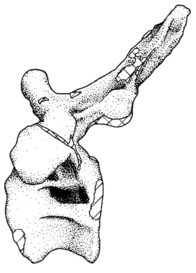 |
| Veterupristisaurus | 2011 | Tendaguru Formation (Late Jurassic, Kimmeridgian to Tithonian) |  Tanzania Tanzania | Known from a few vertebrae somewhat similar to those of Acrocanthosaurus |  |
| Vulcanodon | 1972 | Forest Sandstone (Early Jurassic, Sinemurian to Toarcian) |  Zimbabwe Zimbabwe | Theropod teeth were found associated with the holotype |  |
| Wamweracaudia | 2019 | Tendaguru Formation (Late Jurassic, Tithonian) |  Tanzania Tanzania | The first definitive mamenchisaurid known from outside Asia | |
















































































